Mid-summer 2020, here's a vintage that will mark the smartphone market. The Xiaomi Mi 10T Pro is an excellent value for money flagship with Snapdragon 865, 144Hz screen, 5000mAh battery for less than £ 550. In my full review, I will tell you why the Xiaomi Mi 10T Pro is the best high-end smartphone on the market this year.
Rating
pros
- 108MP camera
- Smooth 144Hz LCD
- Snapdragon 865
- MIUI 12
- 5000mAh battery
Cons
- No dedicated telephoto lens
- No wireless charge
- Advertising in MIUI
- No IP certification
- Non-expandable storage
Who is the Xiaomi Mi 10T Pro for?
Xiaomi MI 10T Pro is available today with two memory configurations. The 8GB / 128GB version costs £ 545 and the 8GB / 256GB model retails for £ 599. The smartphone is available in three colors: Cosmic Black, Lunar Silver and Aurora Blue. The latter is only available for the most expensive 8GB / 256GB version.
As I mentioned in the introduction to this review, here you will find all the key points of an ultra-premium smartphone. The Snapdragon 865 is welcome. I am already attracted by a triple photomodule with a large 108-megapixel sensor. And the 5000mAh battery promises to handle the hefty energy required to power this 144Hz display.
On paper, the Xiaomi Mi 10T Pro is therefore better priced than the Mi 10 Pro and technically better than the Mi 9T Pro, which is still the best smartphone in terms of value for money. But Xiaomi still gives OnePlus a good slap in the face as the OnePlus 8 is more expensive than the base Mi 10T Pro. Of course we are waiting for the OnePlus 8T, but I doubt it will drop below £ 600.
Neat yet protruding design
Like almost every more or less high-end Xiaomi smartphone, the Mi 10T Pro has a very neat design. Glass back, metal edges and flat screen discreetly punctured in the top left corner.
But what is striking when you look at the Xiaomi Mi 10T Pro from the back is the size of the rear photo module. Not only does the large 108MP main sensor look at you like the Eye of Sauron, but the rectangular island that houses the three lenses stands out a lot.
The PV module is large, or rather thick. When you lay your smartphone horizontally, it sways a lot. But it gives the smartphone a rather special, almost human look. I know this is stupid and definitely absurd, and I have an annoying tendency to love "ugly" smartphones like the Vivo X51. But I fully understand that the cyclops eye on the back of a smartphone can scare off more than one customer.
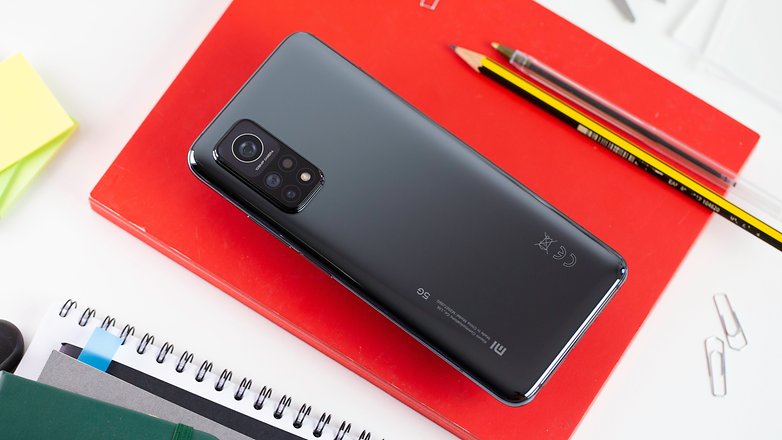
The smartphone as a whole is quite massive, but with excellent grip. The screen, the display, may be flat, but the panel is still curved around the edges. The transverse edges are smoothed out, which interrupts the "curved" movement of the rest of the design, allowing you to hold back the curves of your smartphone like a corset. It's hard for me to put it in writing, but it's a really nice detail.
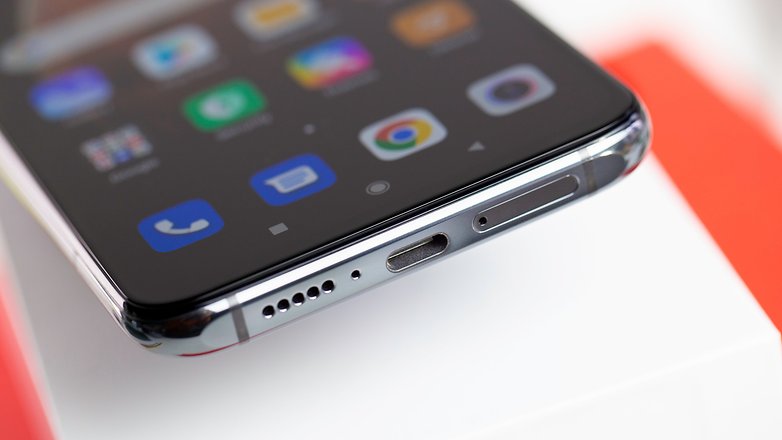
The unlock button, which also houses the fingerprint reader, is positioned fairly well on the right edge of the Xiaomi Mi 10T Pro. At the bottom there is a USB-C port, as well as a speaker and a SIM card slot. There is no way to accommodate a microSD card here, which is unfortunately the standard in this price range. Xiaomi Mi 10T Pro also lacks IP certification for waterproofing.
Overall, the design is not as polished as on the Xiaomi Mi 10 Pro, but I think the smartphone has a certain appeal and I was very pleased to handle it.
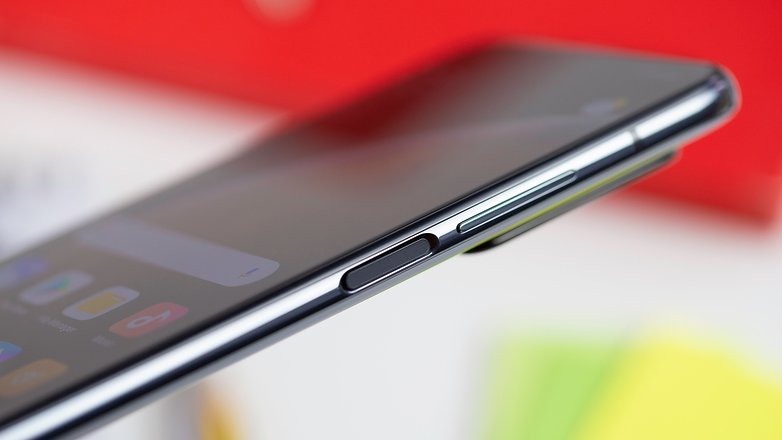
LCD screen, but at 144 Hz
Yes, the LCD screen is a bit sore on the flagship. But Xiaomi promises that "Mi 10T Pro has one of the best LCD screens built into a smartphone."
In use, I have found that the maximum brightness of 650 nits as promised by the manufacturer is very effective in ensuring good readability under all circumstances. The contrast is slightly less compared to the AMOLED panel, and the reflectivity is naturally more noticeable as well.

But to get past, Xiaomi MI 10T Pro offers a 6,67-inch panel with 144Hz refresh rate. A feature that is currently only available on gaming smartphones for the most part. This refresh rate is obviously dynamic, so it adapts to your smartphone and the apps you open, switching between 60Hz and 144Hz to save battery power.
To be honest, I have nothing against LCD screens. There are some really good models on the market and I prefer the 144Hz LCD over the 60Hz AMOLED. But I admit that this is a personal choice. What's more, the refresh rates endlessly advertised for gaming isn't everything.
We also have to talk about the sampling rate of the touchscreen, that is, the number of times per second that the smartphone screen is recorded by touching the fingers. The higher this value, also expressed in Hz, the more sensitive the screen will be for touch operation.
For example, on a high-end gaming smartphone like the Asus ROG Phone 3, the touchscreen sampling rate is 240Hz. On Mi 10T Pro it is 180 Hz. And I can guarantee you will feel the difference in use in terms of sensitivity and tactile feedback.
But this is a boring concern that almost all consumers don't care about. In general, the screen of the Xiaomi Mi 10T Pro is very successful. I understand the choice of LCD panel and do not believe that this negatively affects the user experience due to the smoothness of the display.
MIUI 12: entertainment, security and ... advertising
Much has been said about MIUI 12. The hype surrounding Xiaomi's new overlay was real when it was unveiled last May. I have dedicated a full review article to MIUI 12, which I invite you to read if you want a more complete opinion on this matter.
Visually, the Xiaomi overlay for Android is a real UFO. But it's also highly polished and optimized, and the manufacturer has gone to great lengths to protect privacy, customization, and ergonomics.
On the lock screen, MIUI 12 kicks off the credits and kicks off what feels like a real movie shot in sequence. Let's start with Superboy. This is the function to offer some pretty spectacular animated wallpapers.

You have a choice between three images: Earth (Super Earth), Mars (Super Mars) and Saturn (Super Saturn). When you wake up on a locked screen, the animation starts with a close-up of the planet as seen from space. Once the screen is unlocked, the animation starts a gradual zoom of each planet when you land on the home screen of your Xiaomi smartphone.
At the moment, only a few smartphones offer this feature, and this did not happen with my Xiaomi Mi 10T Pro. But there is a fairly simple method (based on downloading the APK and Google wallpapers) that allows you to enjoy it on almost any Xiaomi smartphone. I made a quick guide for you in case you're interested.
In fact, it never stops, entertainment is everywhere. When opening an app, instead of opening and closing from the middle, each app in MIUI 12 visually opens directly from the app icon and disappears when opened and closed.
We also have an animation in the battery utility, in the storage settings. Animations that can be customized, with different selection of icons, etc. I did not find that the battery was draining more than smartphones with lighter interfaces, and the navigation system was always very smooth. Impressive.
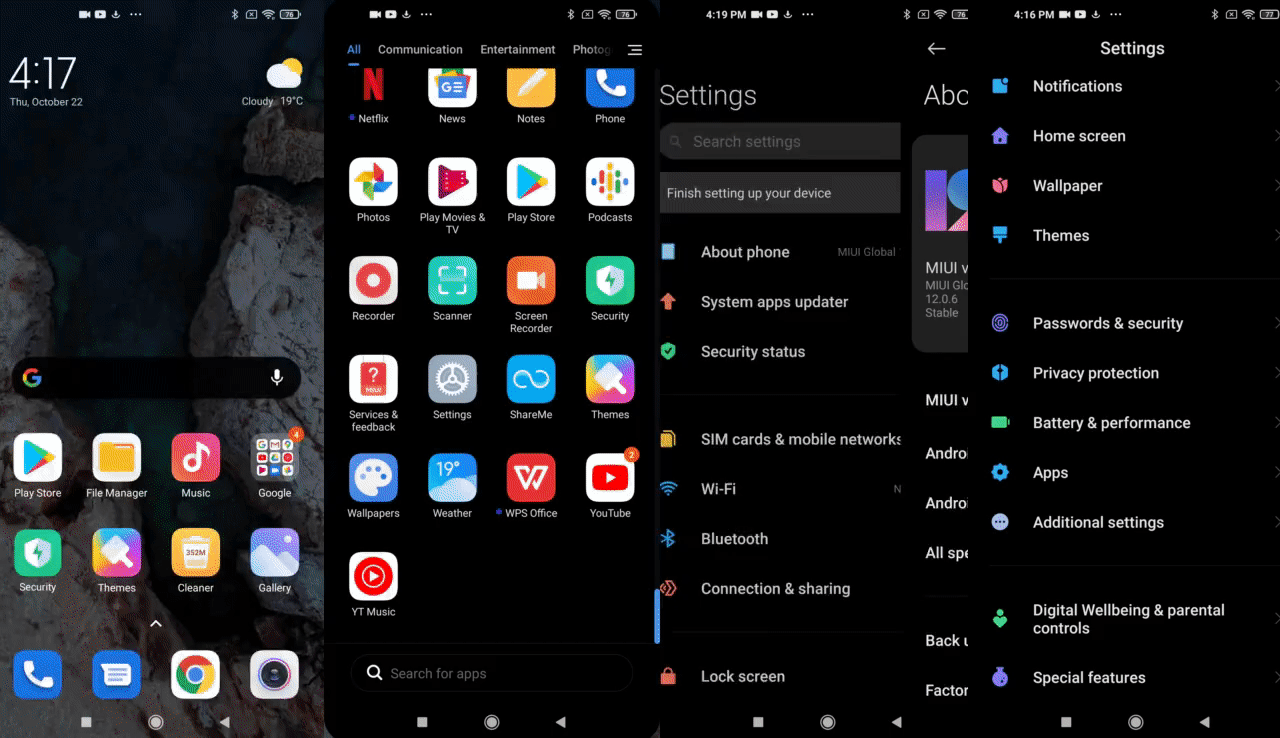
We are also entitled to the Mi Control Center, which is much more than an extended notification dropdown menu. In fact, the top of the screen in MIUI is split in half. Swipe down from the top left corner to the notification screen, and nothing more.
To access the Mi Control Center, you have to swipe in the upper right corner. At first it is a little counterintuitive, but you get used to it harshly. As such, it contains all the system app shortcuts, built-in screen recorder, dark mode, and more, as well as network and Bluetooth connection information.
And if everything is pretty well done and configurable, I regret that not everything, control center and notifications, are in the same place. In any case, I'm ashamed to perform two different gestures to access this information separately.
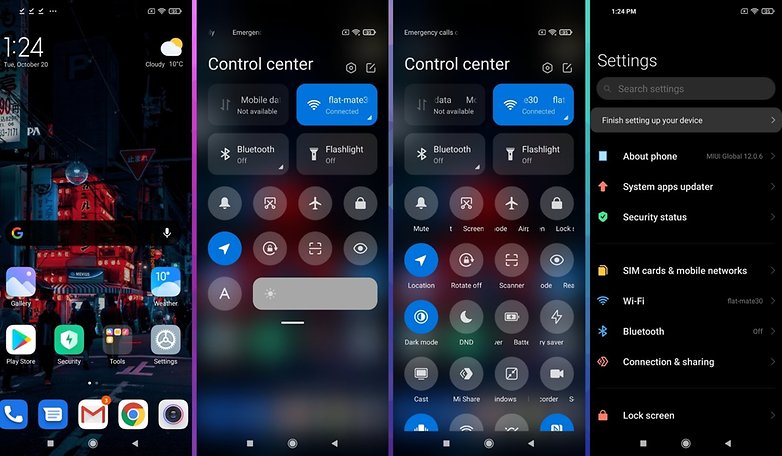
In MIUI 12, Xiaomi also places great emphasis on protecting your personal data. The new interface includes a system for managing authorizations granted to applications. This is a complete overhaul of the permission manager, which allows you to quickly see which apps have which permissions.
You also have notifications every time an app requests access to a camera, microphone, or location, which are displayed in large print and take up almost a third of the screen. When you launch a system app for the first time, MIUI 12 draws your attention to information that the app can access. This feature has been dubbed "Barbed Wire" by Xiaomi.
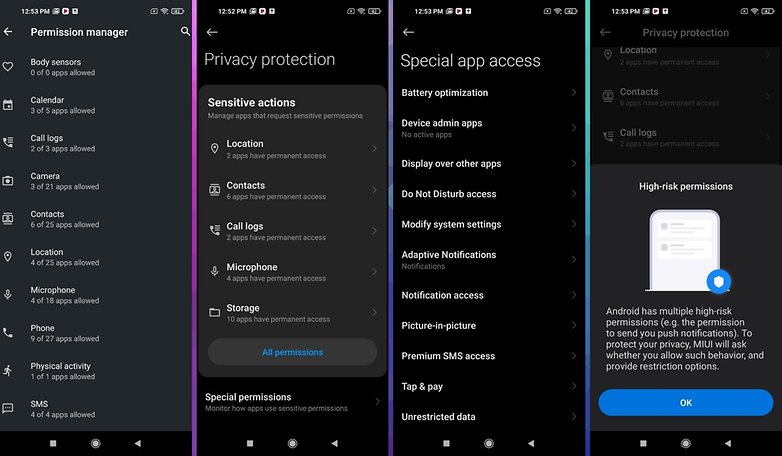
MIUI also sends you an alert when an app tries to use a camera, microphone, or location without your permission. This feature also allows you to log every time an application uses a specific permission. You can see in real time how and when the application accessed your data.
Finally, there is another feature called the mask system, which by default returns bogus or empty messages when a third party application tries to access your call log or messages. This feature is designed to prevent suspicious applications from reading your personal data.
Another strong point in terms of security and privacy is the ability to create a virtual ID. Specifically, MIUI 12 allows you to hide browser personalization behind a virtual profile. You can reset this virtual id whenever you want to clear any usage or preference settings.
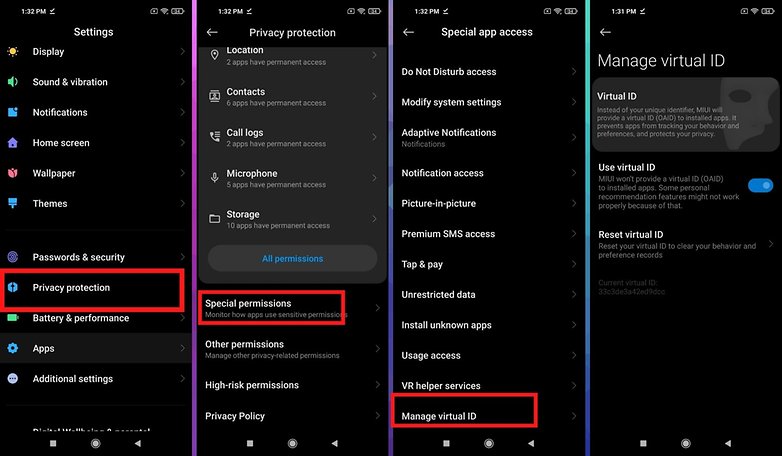
Finally, I should note that at the beginning of my test, I saw ads at the system interface level and in some of my own applications. The Xiaomi Mi 10T Pro that I tested was under the Global ROM and I saw pop-up ads when setting up my smartphone while trying to set dynamic wallpaper. So it was an advertisement in the native Xiaomi Themes app in MIUI 12. Since then I have written a fairly comprehensive guide to getting rid of ads in MIUI and since then I have not seen it during the rest of the test.
I could also tell you about floating windows for multitasking, app drawer, Mi Share, or the new focus mode, but to save you a test that's already endless to read, I'll just redirect you to my MIUI 12 Full Test listed at the top of this section. ...
Overall, with MIUI 12, Xiaomi has managed to convince and seduce the OxygenOS follower that I am. While I prefer lightweight interfaces without being obsessed with Android Stock, I found the MIUI 12 overlay to be very loaded, yet very fluid and very visually pleasing.
It is one of the most atypical interfaces on the market, but also the most advanced.
The power of the Snapdragon 865
It's hard (but not impossible) to find an Android smartphone with a Snapdragon 865 below the £ 600 mark. I am starting to get tired of repeating myself in every test, as almost all of us realized that this high quality SoC always offers very good performance.
The Xiaomi Mi 10T Pro performs very well in 3DMark graphics benchmarks compared to the OnePlus 8T equipped with the same SoC. Compared to high-end gaming smartphones such as the ROG Phone 3 and RedMagic 5S, with more RAM and better temperature control, the results are logically lower.
But with use, you can run the most demanding games with maximum graphics without any problems. I had no problem browsing or multitasking.
Comparison of tests Xiaomi Mi 10T Pro:
| Xiaomi Mi 10T Pro | OnePlus 8T | Red Magic 5S | Asus ROG Phone 3 | |
|---|---|---|---|---|
| 3D Mark Sling Shot Extreme ES 3.1 | 7102 | 7112 | 7736 | 7724 |
| 3D Mark Sling Shot Vulkan | 6262 | 5982 | 7052 | 7079 |
| 3D Mark Sling Shot ES 3.0 | 8268 | 8820 | 9687 | 9833 |
| Geekbench 5 (simple / multi) | 908/3332 | 887/3113 | 902/3232 | 977/3324 |
| PassMark memory | 28045 | 27766 | 27,442 | 28,568 |
| PassMark disk | 94992 | 98574 | 88,322 | 124,077 |
I also ran new 3DMark benchmarks called Wild Life and Wild Life Stress Test. These tests consist of simulations for 1 minute for one and 20 minutes for another intense gaming session with maximum graphics.
These tests are interesting because they inform us about temperature control and the consistency of the FPS displayed on the screen during simulation sessions. Basically, we have a theoretical overview of how the smartphone behaves when launching Call of Duty Mobile with graphics in ultra mode.
During an intense 20-minute session, the Xiaomi Mi 10T Pro maintained a frame rate of 16 to 43 frames per second and a temperature of 32 to 38 ° C. Thus, the critical temperature of 39 ° C was never exceeded. and overheating remains fairly limited.
Xiaomi did not provide details on its internal cooling system. In all cases, the processor and its Adreno 660 GPU coupled with 8GB LPDDR 5 RAM and UFS 3.1 storage provide good gaming performance.
Triple photo module 108 MP
On paper, the large 108MP main sensor forces me to test the smartphone on the spot. We remember the Xiaomi Mi Note 10 - the first smartphone released in Europe with an integrated sensor with such a high resolution, ahead of
Samsung Galaxy S20 Ultra.
In short, on the back panel of the smartphone we find a triple photo module:
- 108MP 1 / 1,33 '' F / 1,69 primary sensor with 4-in-1 Super Pixel, 82 ° FOV and OIS (Optical Stabilization)
- 13MP 1 / 3,06 '' ultra wide-angle sensor with f / 2,4 aperture and 123 ° field of view
- 5 MP 1/5-inch Macro Sensor with F / 2,4 aperture, 82 ° FOV and AF (2-10cm from subject)
The selfie camera features a 20MP 1 / 3,4-inch sensor, F / 2,2 aperture with 77,7 ° FOV and pixel binning technology.
On paper, the Xiaomi Mi 10T Pro has pretty much everything you need. The only thing missing was a dedicated telephoto lens to provide the most flexible range possible, but the manufacturer ignored this.

Pictures of Xiaomi Mi 10T Pro during the day
By default, the Xiaomi Mi 10T Pro takes pictures with a resolution of 27 MP (108 MP / 4) using pixel binning. But you can switch to Pro mode to take shots at full 108 megapixels, which provides better exposure and more detail, although the difference is really subtle.
During the day, even in sub-optimal lighting conditions (thanks for the Berlin climate), the main sensor works very well. Sharpness is there and I was very pleased with the level of detail. The exposition is well organized and the colorimetry is natural.
In ultra wide-angle mode, the quality deteriorates slightly. The photo stays clean, but I noticed a tendency to overexpose. Take a look at the top left image below, it is much brighter and overly lit compared to the rest of the frames.

Xiaomi Mi 10T Pro enlarged photos
The Xiaomi Mi 10T Pro lacks a dedicated telephoto lens to provide the most versatile photo range. Therefore, we can expect digital zoom, which will depend on the high resolution of the 108MP main sensor to crop and crop the image for zoom application.

The maximum scaling you can apply is x30 magnification. The latter is impossible to use and, in any case, does not matter for handheld photography without a tripod. Otherwise, from x2 to x10 zoom, I found the results to be significantly better than what I was able to achieve with the OnePlus 8T and its 48MP sensor.
Again, you see the uselessness of the 30x zoom without a tripod, the grain is everywhere, and the pixel porridge almost makes it impossible to distinguish the German lettering on the panel. But I found that zooming in on x2 and x5 was effective enough to limit the loss of detail.

Photos of Xiaomi Mi 10T Pro at night
At night, the Xiaomi Mi 108T Pro's 10MP wide-angle sensor performs remarkably well, even better with dedicated night mode. The latter allows the scene to be well lit without burning the photo by exuding too many bright light sources, such as city lighting.
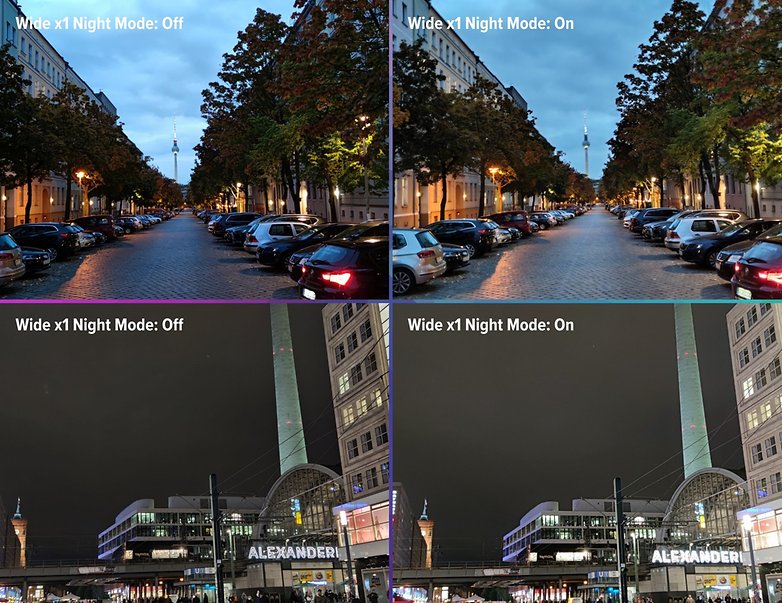
We may mark too much anti-aliasing to reduce digital noise, which causes the images to lose sharpness. The ultra wide angle lens is really bad in low light, but I found the zoom to be effective, especially in terms of the level of detail.
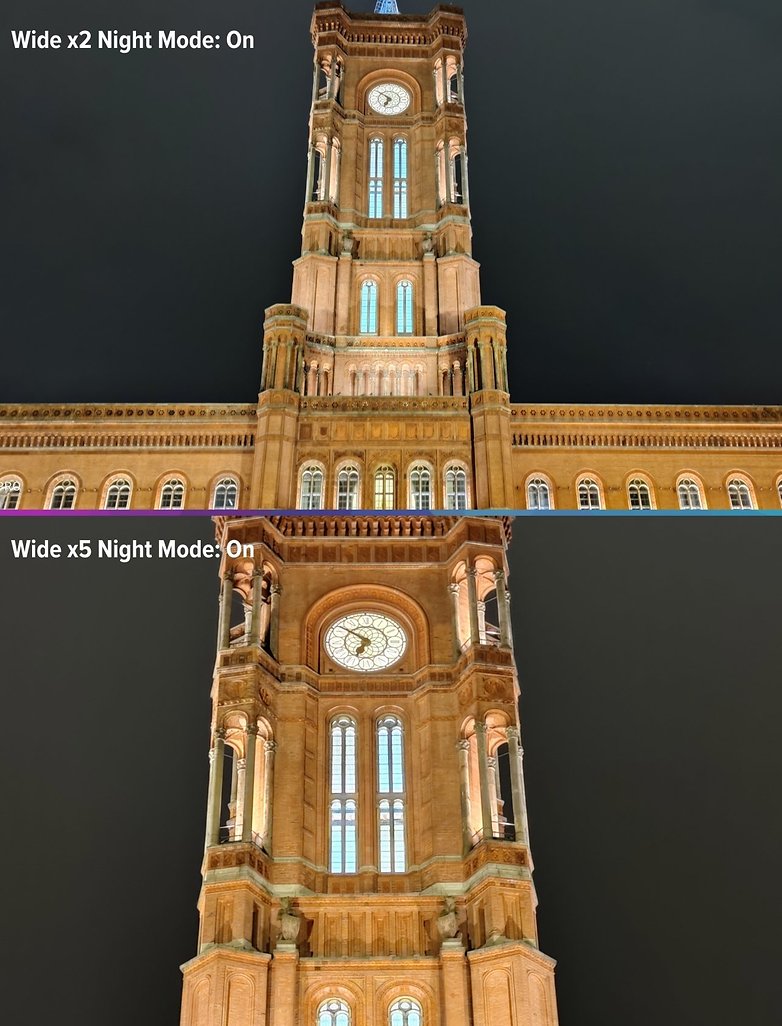
In general, the Xiaomi Mi 10T Pro photo module ideally matches the price of a smartphone. Wide-angle shots are excellent day and night. The magnification remains effective as long as it is limited to an increase of x2 or even x5 maximum. The ultra-wide-angle lens is too average for a smartphone that wants to be high-end, but the powerful night mode is catching up with the photo module, which I find more efficient than the OnePlus 8T sold at the same price.
But I can't help but think that a telephoto lens would be better than a macro sensor, even if this time we don't get a macro with ridiculous 2MP but 5MP resolutions.
Impressive battery life
Xiaomi Mi 10T Pro is equipped with a 5000mAh battery. It's a big battery, more than welcomed to recoup the energy costs associated with a high refresh rate display.
For charging, the Xiaomi Mi 10T Pro comes with a 33W (11V / 3A) charger. Enough to charge it from 10 to 100% in just an hour. A very good result, especially considering the large battery of Mi 10T Pro. However, please note that the smartphone does not support wireless charging.
During the test, I used Xiaomi Mi 10T Pro with a dynamic refresh rate of 144 Hz (for example, in the system interface it goes to 60 Hz, and in the game - 144 Hz), as well as with adaptive brightness. Overall, I lasted over 20 hours on average before dropping below 20% of my remaining battery life. TWENTY HOURS! And that's with over six hours of screen time spent on mobile gaming, video calling and streaming video.
I tell myself that with a locked screen at 60Hz and less intensive use, such as a screen time of three hours, the battery life should exceed two full days of use. This is a real breakthrough for Xiaomi and an optimization lesson for competitors.
Even with the PCMark test we use for the battery and which simulates unrealistic use due to too high load on the smartphone, the Xiaomi Mi 10T Pro lasted 23 hours before dropping below 20% of the remaining battery level. ...
I know some Samsung smartphones and iPhones that should be kind enough to sit down, take notes and look through their copies, because Xiaomi is a class leader in this price category.
The final verdict
Xiaomi Mi 10T Pro is one of the smartphones, together with Poco F2 Pro, OnePlus 8T or Oppo Reno 4, which form a new intermediate line of “affordable” flagships. We have almost all the premium specs without having to pay more than £ 1000.
The 108MP triple photomodule is very good except for the ultra-wide angle one, the Snapdragon 865 delivers excellent performance, the 144Hz LCD screen is very smooth and the 5000mAh battery is impressive. I've rarely used so many superlatives in a review, and if you read me regularly, you know how much I “suck” in my reviews.
But in terms of value for money for a flagship, we can hardly do more. I still prefer the OnePlus 8T, but it's actually my (entirely assumed) bias that makes me say this, as does my attachment to OxygenOS 11.
When we know that Xiaomi Mi 9T Pro, its predecessor, was a champion in terms of price / performance ratio and that in 2020 it is still at the top of the basket of reviews and other buying guides, we can say that the Xiaomi Mi 10T Pro is a decent one. representative of their ancestry.
If I had to recommend a flagship in 2020 and I had to ignore my bias towards OnePlus, the Xiaomi Mi 10T Pro would undoubtedly be one of the best options if you want value for money.



